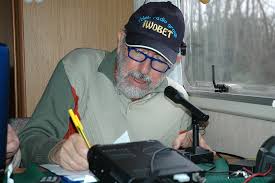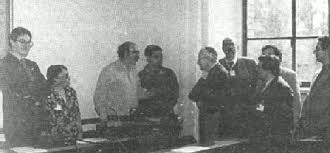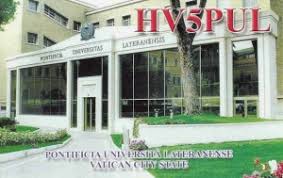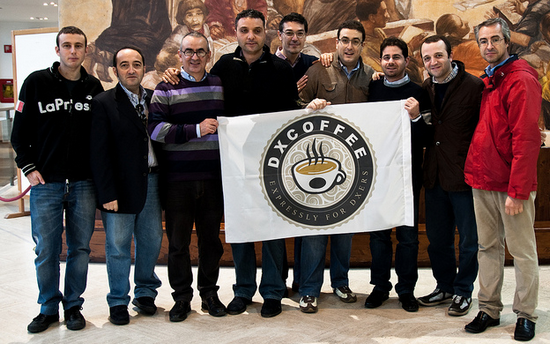History
1 – The Birth of HV5PUL
It’s not easy to talk about HV5PUL because the first question somebody will ask is, ” how do you get a license from the Vatican?” It’s a question I can'’t really answer. I can only explain how it worked for HV5PUL.
Let’s begin with another story from Giovanni Zangara, IW0BET, my mentor during my first few years in radio who helped me for many years in serving as QSL Manager. He helped me for many years in serving as QSL Manager. Giovanni was a great OM, having also participated in the first activation of 1A0KM, having told me the story of that legendary station that I had the privilege of being able to activate years later.
Now is SK and to him I owe my thanks and the most heartfelt memory and remembrance in prayer.
He told me tha two careless (or overly intelligent) German hams take up lodging near a convent in the papal prefecture and go mad happy with the indicator /HV. Well, this was not pleasing to the Holy See and the case was closed with the end result such that private individuals could not operate radio stations at the Vatican.
 IW0BET Giovanni
IW0BET Giovanni
I learned of this story sometime after the issuance of HV5PUL. However, it demonstrated that the path which I followed was correct: the license, having been granted by the Vatican Prefecture, something for which I had worked. In fact, all licenses up until 1998, the year that HV5PUL was born, were granted, as a result, to institutions and not to individuals. HV1CN (Vatican Radio), HV2VO (Vatican Observatory), HV3SJ (Jesuit curia) and HV4NAC (North American College). Each of them had a radio amateur who was responsible, once the callsign had been assigned. Besides, it wasn’t my intention to have a personal callsign, but to activate a station to reach out to the world, the world of radio amateurs at Pontifical Lateran University and the newly formed International Association, whose intention was to reunite ex-alumni and friends of the alma mater. Having put forward the idea at a meeting of the President’s Council, the decision was a positive one. In a lucky turn of events, Cardinal Edmund C. Szoka, at the time, President of the Vatican City State and President of the Alumni Association and in as much, an alumnus of Lateran University and Pontifical Lateran University; he now had his radio station. The deal wasn’t “cut and dry,” but after a process involving the Governor of the State and the Secretary of State of the Holy See, all the approvals were collected and the two letters of authorization were delivered just in time for the Second Lateran Day, April 23, 1998, the official date of birth of HV5PUL.
 His Eminence the Cardinal Edmund C. Szoka meet the ARI Roma Team during the first activation
His Eminence the Cardinal Edmund C. Szoka meet the ARI Roma Team during the first activation
The first team was composed of radio amateurs from the Rome section of the ARI which Giovanni introduced me to and gave credit to a poor IW (a special license call in italy) who had ventured into “terra incognita.” I assure you that, in the beginning, few believed in the project (and all of them wanted to see the license). And I want to thank all those who supported me with the initial installation providing me with the necessary materials. They are IK0YQJ Francis Caccamo, IK0OER Stefano Caranfil, I0GOJ Tony Giudici, IK0FTA Sergio Roca, IK0OKY Emilio Cutolo, IK0WRB Vinicio Coletti and IW0BET, Giovanni Zangara.
Oh yes, the license. What’s a Vatican license look like? It’s not like your standard permit or ID stamped in plastic. It’s a simple letter on letterhead (and not even written in Latin!). It does’nt have an expiration date or any notations requiring an annual fee. What satisfaction we received from this way of doing things! Well, if you had the patience to read this article and you liked it, please let me know, because this is only the beginning of the story!
2 – The Glory Years
Now having authorization and a callsign, we now needed to set up the station. Initial activation took place with the bare necessities. No linears, no multi-element monobanders; in the end, nothing that you would have dreamed of taking with you on a DXpedition.
In reality, the situation was much more similar to that of a condo in the city, with the only difference being that you don’t sleep there during the night and you’re active during the day. And instead of causing TVI for the old neighbor lady who’s watching TV, you cause RF interference to colleagues and classrooms where lessons are being taught; where they tell you that strange “Donald Duck’-like” voices are coming through the loudspeakers. Therefore, low power, make the call and listen…Our Roman friends loaned me a pair of verticals for HF, a dipole and I successfully placed two beams for two and six meters on a TV rotor which had kindly been given me. The station was setup for the first time in a ground floor classroom. So, we had long a ways to the roof to reach the antenna.
Operations took place during the course of Lateran Day, an event which repeats itself every year and which is represented as an “open house” of sorts for the university. During the course of activation, we received a visit from Cardinal Szoka, accompanied by then Rector of the University, later Patriarch of Venice, Archbishop of Milan and now emeritus, the Cardinal Angelo Scola, along with a representative of the Italian government, Doctor Vinci. Students and teachers stopped by as well, as our display was open to all. By the end of the day, the first 831 QSOs had been realized, after being active on 40, 20, 15 and 6 meters. I was tired and rather pleased when we got a nice phone call that evening: it was Francesco Valsecchi, IK0FVC who was quite pleased with the operation and the fact that he wasn’t the only one anymore taking charge of an HV call.
I had entered the world of the “most wanted” DX and I won’t hide from you my satisfaction at that moment. In the years to follow, I have tried to share the “wonder” of this with others, enriching human relationships and friendships which still endure, despite the passage of time, family commitments and work.
I can also assure you, as an IW, I “chomped at the bit” the first few years, not being able to get on HF. However, I remained in awe of my telegrapher friends, quite the QSO machines. There were always three or four of us operating in a quite “down to earth” and friendly atmosphere, without any permanent facilities and fancy equipment. But it was enough, however, for the call to cause a pile-up and to generate interest manifested itself in hundreds of QSLs.
After some time I found a location on the top floor which was able to be used as a “shack” for the operators. Having direct access to the terrace area and apart from the QRM caused by the water pumps, along with the lack of heat, it suited our needs. Several operators were guests in those years and among these, I remember with pleasure the participants at the conference of radio-scout leaders which was held in Rome. All in rank and file, disciplined, up the access stairs to the station to operate ten minutes, just to be able to say: I operated as an HV.
The actual HV5PUL QSL Card

The high point of those years was no doubt the station’s activation on an April night in 2000 during which master telegraphers Tony I0GOJ and Claudio Tata IK0XCB were working a pileup of American stations on 40 and 80 meters, operating with a CP6 vertical on 3.5 Mhz and a dipole on 7 Mhz. In one night nearly 4000 QSOs were made, including Stefano, IK0OER on 20 meter SSB. The “deciding” moment happened when a little birdie suggested to work split, listening above 7.100 Mhz and work American stations on phone.
I would like to make special mention of six meters, which in Rome, saw years of particular interest, and even moreso on six meters because of all the IW stations. The “magic band” had the right spot in HV operations and reached its pinacle, culminating with some “new ones,” thanks to the magnificent 6 element JXX mounted specifically to take advandage of Transequatorial Propagation with Southern Africa. And then came total exhilaration for me, a Sporadic-E pileup during which other operators also had the opportunity to attempt to secure a contact with HV, while trying to find the right frequency for this “unusual” event.
3 – New friends , new experiences
Going back to the year 2000, the University had begun big plans in renovation of classroom and office space. The location where the station was set up, was completely dismantled, restored and converted into office space for the teachers. The station was part of this work as well. And bad weather caused it’s share of damage on the ground having torn up the 6 and 2 meter beams and then the three element HF yagi which had already been reduced to a simple dipole.
New “guest operators” had ways of working from the Vatican, amongst whom is now a great member of the family: Tom W9AEB who had visited Rome several times. So, there are two collaborators of DxCoffee: Antonello Scauso IT9YVO and Giorgio Minguzzi IZ4AKS. It was with Giorgio when I then had the honor of activating 1A4A from SMOM (Solemn Military Order of Malta) with Massimo Cortesi, IZ4DPV and other friends who also participated in CQWW, like 1A3A (Giorgio when we visited backstage? )
Various groups had the chance to operate HV5PUL: the Scouts, COTA (Carabineers on the Air), Radio Amateurs of Saronno; and to finish it all off, the editorial staff of DXCoffee! I don’t have the exact count, but I think that we’ve had at least thirty different operators pass this way. In this regard I’d like to make a plea: anybody with pictures from when they operated or sat at the mic of HV5PUL, please get in touch with me. I would like to put together a guest book with photos of all operators.

The DX Coffee Team at HV5PUL
Operating from HV5PUL
As far as QSL cards go, I have responded, with the important help of IW0BET, to more than 26,000 QSOs including the LOTW. Not that much time has passed.
Generally, it takes at most about two months to respond to everyone. For this reason, please be patient and do not react as did one Japanese, seven requests to three addresses within two weeks. On a more colorful note: a Brazilian having seen the “somber” character of the station, sent us his QSL, depicting a beauty on a Cocacabana beach, completely “redressed” in body paint.
Working as manager of HV5PUL, I’ve noticed that often one does not pay much attention as to how to send the right QSL card, without the risk of never seeing one back. But we’ll not speak of this…
Operating from HV5PUL means subjecting yourself to certain limitations of time, power and space. Anybody that’s been there will affirm that any given location cannot accomodate a lot of operators and therefore, you’ll need a lot of patience. Also, operating power will be limited if there are lectures or meetings in progress, in order not to cause TVI. Station hours are always tied to the opening of the university. So, the most difficult official hours are on Saturday. The actual setup consists of a 5-band vertical and a three element yagi for six meters. I also have a loop for 40 meters. This band is the hardest to work because of terrible QRM which literally “kills” signals and with the loop I’ve had plenty of respectable results with respect to verticals and dipoles.